Business Strategies Report: Macro and Internal Analysis of Starbucks
VerifiedAdded on 2023/01/12
|13
|4322
|70
Report
AI Summary
This report provides a comprehensive analysis of Starbucks' business strategies. It begins with an examination of the macro environment using PESTEL analysis, exploring political, economic, social, technological, environmental, and legal factors impacting the company. The report then delves into the internal environment, utilizing SWOT and VRIO models to evaluate Starbucks' strengths, weaknesses, opportunities, threats, and core competencies. Furthermore, it applies Porter's Five Forces model to assess the competitive landscape within the coffee industry. The report concludes with an overview of strategic planning concepts and frameworks relevant to Starbucks, offering insights into how the company navigates its market and maintains its competitive advantage. The analysis covers various aspects of the company's operations and strategic decision-making processes.

BUSINESS
STRATEGIES
STRATEGIES
Paraphrase This Document
Need a fresh take? Get an instant paraphrase of this document with our AI Paraphraser

Table of Contents
INTRODUCTION ..........................................................................................................................3
TASK 1 ..........................................................................................................................................3
P1 Using different frameworks examine the impact of macro environment .............................3
TASK 2............................................................................................................................................5
P2 Evaluate internal environment and capabilities of enterprises..............................................5
TASK 3............................................................................................................................................8
P3 Use Porter Five force model in relevance with organisation.................................................8
TASK 4..........................................................................................................................................10
P4 Apply concept/ frameworks for strategic planning in relevance with organisation ...........10
CONCLUSION..............................................................................................................................11
REFERENCES..............................................................................................................................12
BOOKS & JOURNAL:.............................................................................................................12
INTRODUCTION ..........................................................................................................................3
TASK 1 ..........................................................................................................................................3
P1 Using different frameworks examine the impact of macro environment .............................3
TASK 2............................................................................................................................................5
P2 Evaluate internal environment and capabilities of enterprises..............................................5
TASK 3............................................................................................................................................8
P3 Use Porter Five force model in relevance with organisation.................................................8
TASK 4..........................................................................................................................................10
P4 Apply concept/ frameworks for strategic planning in relevance with organisation ...........10
CONCLUSION..............................................................................................................................11
REFERENCES..............................................................................................................................12
BOOKS & JOURNAL:.............................................................................................................12
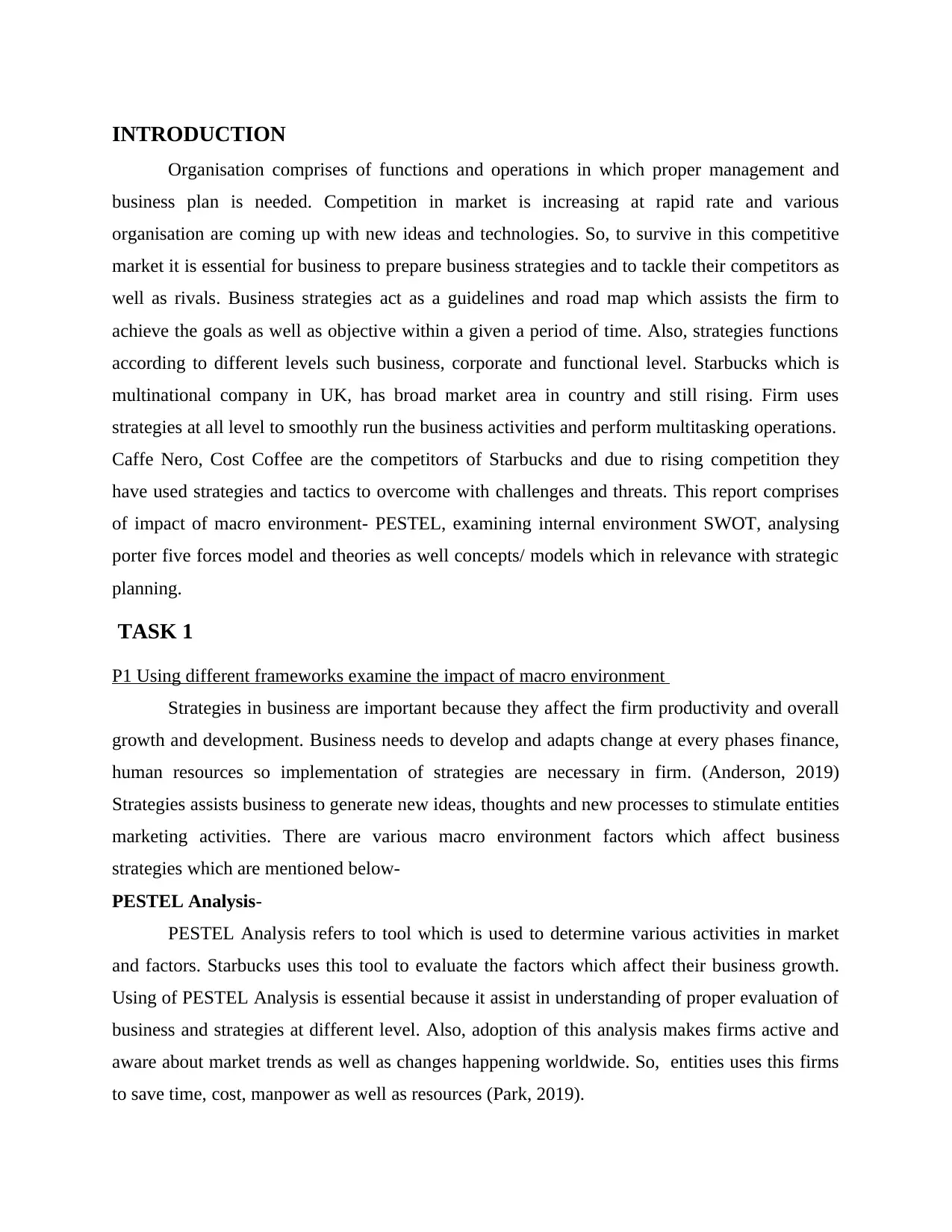
INTRODUCTION
Organisation comprises of functions and operations in which proper management and
business plan is needed. Competition in market is increasing at rapid rate and various
organisation are coming up with new ideas and technologies. So, to survive in this competitive
market it is essential for business to prepare business strategies and to tackle their competitors as
well as rivals. Business strategies act as a guidelines and road map which assists the firm to
achieve the goals as well as objective within a given a period of time. Also, strategies functions
according to different levels such business, corporate and functional level. Starbucks which is
multinational company in UK, has broad market area in country and still rising. Firm uses
strategies at all level to smoothly run the business activities and perform multitasking operations.
Caffe Nero, Cost Coffee are the competitors of Starbucks and due to rising competition they
have used strategies and tactics to overcome with challenges and threats. This report comprises
of impact of macro environment- PESTEL, examining internal environment SWOT, analysing
porter five forces model and theories as well concepts/ models which in relevance with strategic
planning.
TASK 1
P1 Using different frameworks examine the impact of macro environment
Strategies in business are important because they affect the firm productivity and overall
growth and development. Business needs to develop and adapts change at every phases finance,
human resources so implementation of strategies are necessary in firm. (Anderson, 2019)
Strategies assists business to generate new ideas, thoughts and new processes to stimulate entities
marketing activities. There are various macro environment factors which affect business
strategies which are mentioned below-
PESTEL Analysis-
PESTEL Analysis refers to tool which is used to determine various activities in market
and factors. Starbucks uses this tool to evaluate the factors which affect their business growth.
Using of PESTEL Analysis is essential because it assist in understanding of proper evaluation of
business and strategies at different level. Also, adoption of this analysis makes firms active and
aware about market trends as well as changes happening worldwide. So, entities uses this firms
to save time, cost, manpower as well as resources (Park, 2019).
Organisation comprises of functions and operations in which proper management and
business plan is needed. Competition in market is increasing at rapid rate and various
organisation are coming up with new ideas and technologies. So, to survive in this competitive
market it is essential for business to prepare business strategies and to tackle their competitors as
well as rivals. Business strategies act as a guidelines and road map which assists the firm to
achieve the goals as well as objective within a given a period of time. Also, strategies functions
according to different levels such business, corporate and functional level. Starbucks which is
multinational company in UK, has broad market area in country and still rising. Firm uses
strategies at all level to smoothly run the business activities and perform multitasking operations.
Caffe Nero, Cost Coffee are the competitors of Starbucks and due to rising competition they
have used strategies and tactics to overcome with challenges and threats. This report comprises
of impact of macro environment- PESTEL, examining internal environment SWOT, analysing
porter five forces model and theories as well concepts/ models which in relevance with strategic
planning.
TASK 1
P1 Using different frameworks examine the impact of macro environment
Strategies in business are important because they affect the firm productivity and overall
growth and development. Business needs to develop and adapts change at every phases finance,
human resources so implementation of strategies are necessary in firm. (Anderson, 2019)
Strategies assists business to generate new ideas, thoughts and new processes to stimulate entities
marketing activities. There are various macro environment factors which affect business
strategies which are mentioned below-
PESTEL Analysis-
PESTEL Analysis refers to tool which is used to determine various activities in market
and factors. Starbucks uses this tool to evaluate the factors which affect their business growth.
Using of PESTEL Analysis is essential because it assist in understanding of proper evaluation of
business and strategies at different level. Also, adoption of this analysis makes firms active and
aware about market trends as well as changes happening worldwide. So, entities uses this firms
to save time, cost, manpower as well as resources (Park, 2019).
⊘ This is a preview!⊘
Do you want full access?
Subscribe today to unlock all pages.

Trusted by 1+ million students worldwide
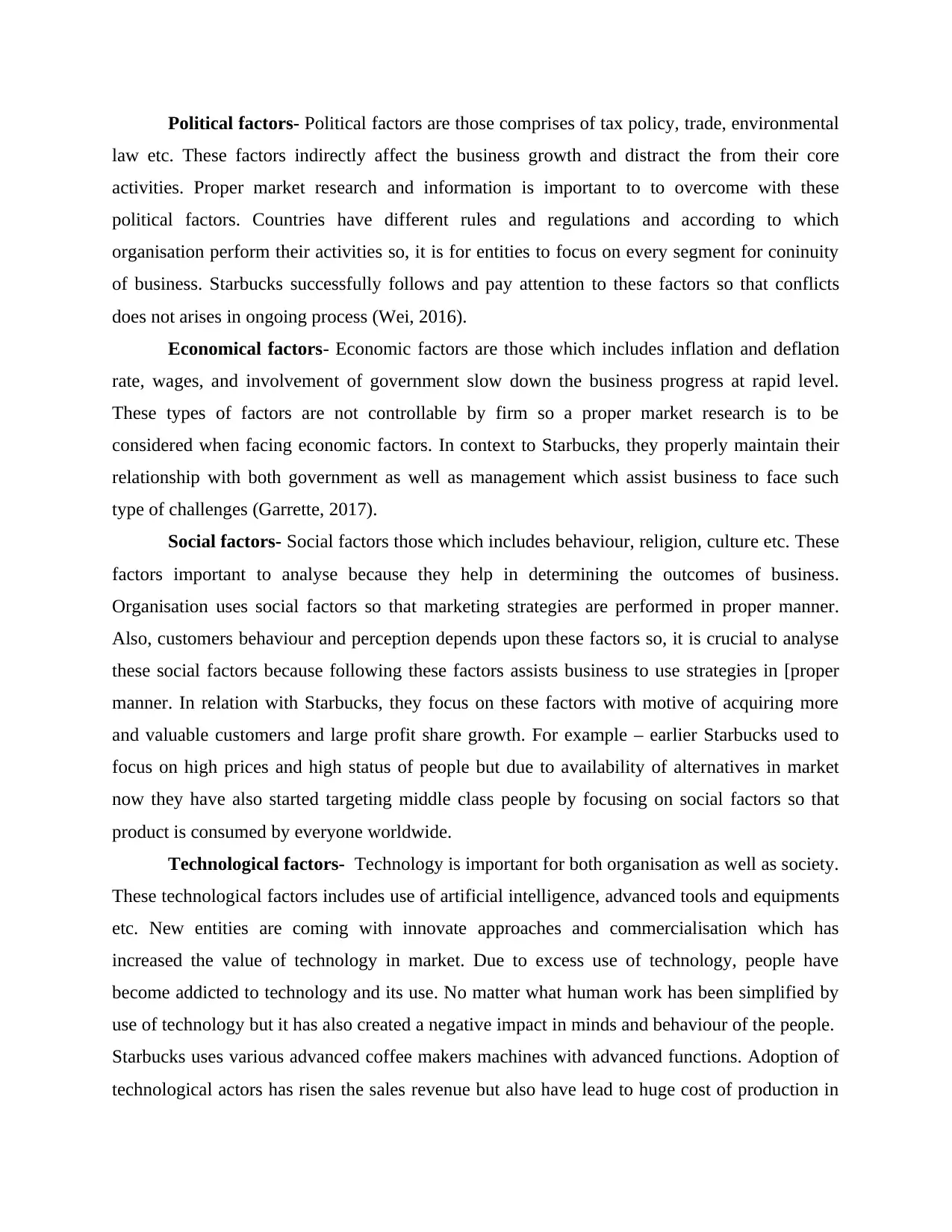
Political factors- Political factors are those comprises of tax policy, trade, environmental
law etc. These factors indirectly affect the business growth and distract the from their core
activities. Proper market research and information is important to to overcome with these
political factors. Countries have different rules and regulations and according to which
organisation perform their activities so, it is for entities to focus on every segment for coninuity
of business. Starbucks successfully follows and pay attention to these factors so that conflicts
does not arises in ongoing process (Wei, 2016).
Economical factors- Economic factors are those which includes inflation and deflation
rate, wages, and involvement of government slow down the business progress at rapid level.
These types of factors are not controllable by firm so a proper market research is to be
considered when facing economic factors. In context to Starbucks, they properly maintain their
relationship with both government as well as management which assist business to face such
type of challenges (Garrette, 2017).
Social factors- Social factors those which includes behaviour, religion, culture etc. These
factors important to analyse because they help in determining the outcomes of business.
Organisation uses social factors so that marketing strategies are performed in proper manner.
Also, customers behaviour and perception depends upon these factors so, it is crucial to analyse
these social factors because following these factors assists business to use strategies in [proper
manner. In relation with Starbucks, they focus on these factors with motive of acquiring more
and valuable customers and large profit share growth. For example – earlier Starbucks used to
focus on high prices and high status of people but due to availability of alternatives in market
now they have also started targeting middle class people by focusing on social factors so that
product is consumed by everyone worldwide.
Technological factors- Technology is important for both organisation as well as society.
These technological factors includes use of artificial intelligence, advanced tools and equipments
etc. New entities are coming with innovate approaches and commercialisation which has
increased the value of technology in market. Due to excess use of technology, people have
become addicted to technology and its use. No matter what human work has been simplified by
use of technology but it has also created a negative impact in minds and behaviour of the people.
Starbucks uses various advanced coffee makers machines with advanced functions. Adoption of
technological actors has risen the sales revenue but also have lead to huge cost of production in
law etc. These factors indirectly affect the business growth and distract the from their core
activities. Proper market research and information is important to to overcome with these
political factors. Countries have different rules and regulations and according to which
organisation perform their activities so, it is for entities to focus on every segment for coninuity
of business. Starbucks successfully follows and pay attention to these factors so that conflicts
does not arises in ongoing process (Wei, 2016).
Economical factors- Economic factors are those which includes inflation and deflation
rate, wages, and involvement of government slow down the business progress at rapid level.
These types of factors are not controllable by firm so a proper market research is to be
considered when facing economic factors. In context to Starbucks, they properly maintain their
relationship with both government as well as management which assist business to face such
type of challenges (Garrette, 2017).
Social factors- Social factors those which includes behaviour, religion, culture etc. These
factors important to analyse because they help in determining the outcomes of business.
Organisation uses social factors so that marketing strategies are performed in proper manner.
Also, customers behaviour and perception depends upon these factors so, it is crucial to analyse
these social factors because following these factors assists business to use strategies in [proper
manner. In relation with Starbucks, they focus on these factors with motive of acquiring more
and valuable customers and large profit share growth. For example – earlier Starbucks used to
focus on high prices and high status of people but due to availability of alternatives in market
now they have also started targeting middle class people by focusing on social factors so that
product is consumed by everyone worldwide.
Technological factors- Technology is important for both organisation as well as society.
These technological factors includes use of artificial intelligence, advanced tools and equipments
etc. New entities are coming with innovate approaches and commercialisation which has
increased the value of technology in market. Due to excess use of technology, people have
become addicted to technology and its use. No matter what human work has been simplified by
use of technology but it has also created a negative impact in minds and behaviour of the people.
Starbucks uses various advanced coffee makers machines with advanced functions. Adoption of
technological actors has risen the sales revenue but also have lead to huge cost of production in
Paraphrase This Document
Need a fresh take? Get an instant paraphrase of this document with our AI Paraphraser

the company. They also use technology for communicating, digital platform for their business
and advanced management online system.
Environmental factors- Another external macro factor is environmental factor which
comprises of weather, temperature, etc. Such types of factors affect the marketing, advertising
and promotional tools of a firm. So, Starbucks uses different tools and equipments to measure
such factors so that all the activities relating to environmental factors are carried out in proper
and effective manner.
Legal factors- Legal factors are those which includes antitrust law, commitment,
agreement etc. Such type of legal factors are important to be considered because avoiding these
factors affect the firm overall growth and development. In context to Starbucks, they have
properly focused on these legal factors so that function and operation of business does not get
affected (Gürel, 2017).
Thus after examining above macro environmental factor it can be stated that organisation
adopts different strategies and tools to track and monitor the market situation as well as activities
. PESTEL Analysis assists the business to overcome with external factors so that core activities
are carried out in effective manner. Firm uses PESTEL to prevent themselves from uncertain
occurring of events. Using of PESTEL has helped Starbucks to boost up their growth and
marketing process at wider level (Bull, 2016).
TASK 2
P2 Evaluate internal environment and capabilities of enterprises
Internal environment are those which are controllable by firm up-to some degree of
extent. To analyse internal environment, SWOT is used by marketers as well as entities. SWOT
is tool used by entities to track and monitor market trends and situations.
SWOT Analysis
STRENGTH
Starbucks main strength is their
formula of making coffee is
confidential which makes them unique
from their competitors.
WEAKNESS
Most of the Starbucks products such as
pumpkin spice lattes, does not have
huge market in business due to high
pricing of product and services.
and advanced management online system.
Environmental factors- Another external macro factor is environmental factor which
comprises of weather, temperature, etc. Such types of factors affect the marketing, advertising
and promotional tools of a firm. So, Starbucks uses different tools and equipments to measure
such factors so that all the activities relating to environmental factors are carried out in proper
and effective manner.
Legal factors- Legal factors are those which includes antitrust law, commitment,
agreement etc. Such type of legal factors are important to be considered because avoiding these
factors affect the firm overall growth and development. In context to Starbucks, they have
properly focused on these legal factors so that function and operation of business does not get
affected (Gürel, 2017).
Thus after examining above macro environmental factor it can be stated that organisation
adopts different strategies and tools to track and monitor the market situation as well as activities
. PESTEL Analysis assists the business to overcome with external factors so that core activities
are carried out in effective manner. Firm uses PESTEL to prevent themselves from uncertain
occurring of events. Using of PESTEL has helped Starbucks to boost up their growth and
marketing process at wider level (Bull, 2016).
TASK 2
P2 Evaluate internal environment and capabilities of enterprises
Internal environment are those which are controllable by firm up-to some degree of
extent. To analyse internal environment, SWOT is used by marketers as well as entities. SWOT
is tool used by entities to track and monitor market trends and situations.
SWOT Analysis
STRENGTH
Starbucks main strength is their
formula of making coffee is
confidential which makes them unique
from their competitors.
WEAKNESS
Most of the Starbucks products such as
pumpkin spice lattes, does not have
huge market in business due to high
pricing of product and services.
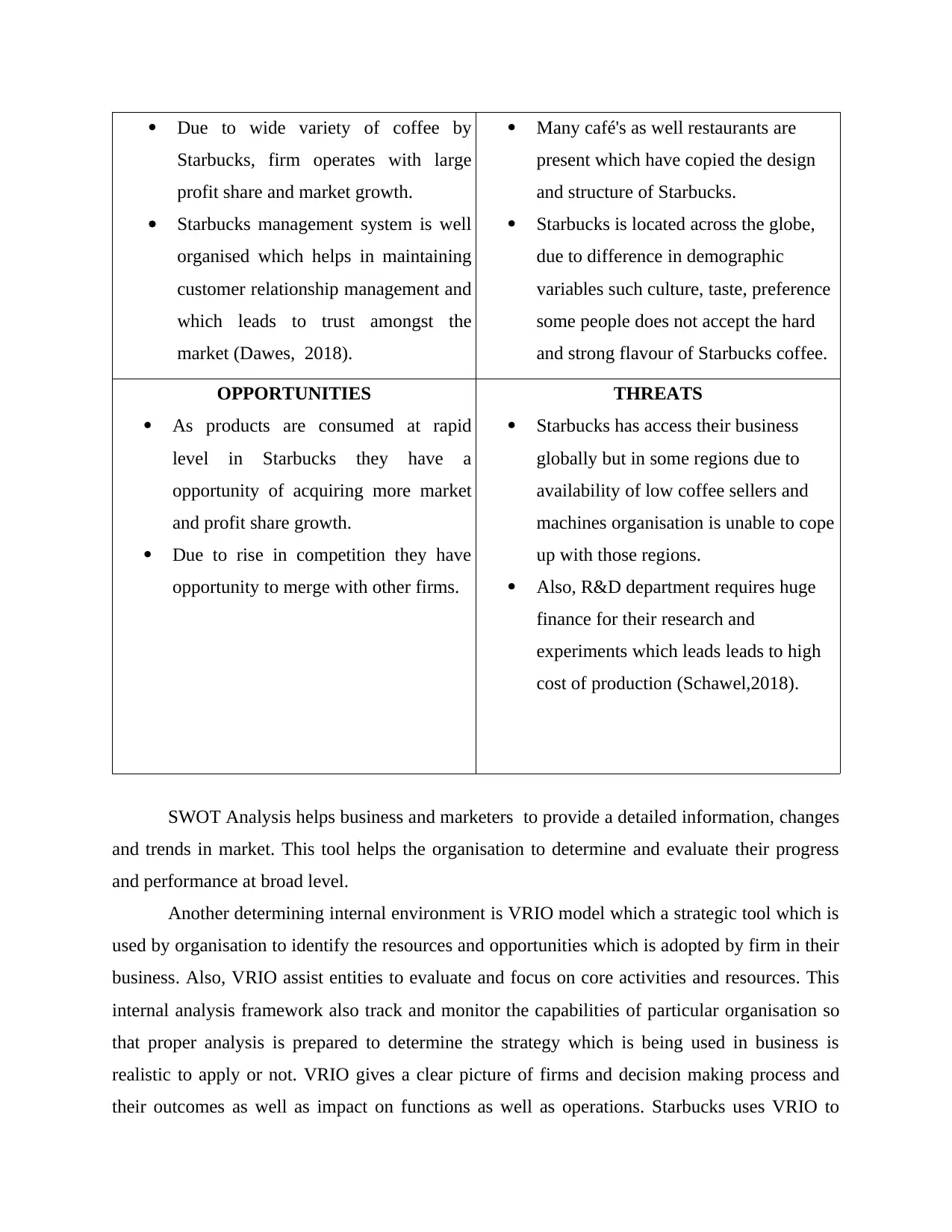
Due to wide variety of coffee by
Starbucks, firm operates with large
profit share and market growth.
Starbucks management system is well
organised which helps in maintaining
customer relationship management and
which leads to trust amongst the
market (Dawes, 2018).
Many café's as well restaurants are
present which have copied the design
and structure of Starbucks.
Starbucks is located across the globe,
due to difference in demographic
variables such culture, taste, preference
some people does not accept the hard
and strong flavour of Starbucks coffee.
OPPORTUNITIES
As products are consumed at rapid
level in Starbucks they have a
opportunity of acquiring more market
and profit share growth.
Due to rise in competition they have
opportunity to merge with other firms.
THREATS
Starbucks has access their business
globally but in some regions due to
availability of low coffee sellers and
machines organisation is unable to cope
up with those regions.
Also, R&D department requires huge
finance for their research and
experiments which leads leads to high
cost of production (Schawel,2018).
SWOT Analysis helps business and marketers to provide a detailed information, changes
and trends in market. This tool helps the organisation to determine and evaluate their progress
and performance at broad level.
Another determining internal environment is VRIO model which a strategic tool which is
used by organisation to identify the resources and opportunities which is adopted by firm in their
business. Also, VRIO assist entities to evaluate and focus on core activities and resources. This
internal analysis framework also track and monitor the capabilities of particular organisation so
that proper analysis is prepared to determine the strategy which is being used in business is
realistic to apply or not. VRIO gives a clear picture of firms and decision making process and
their outcomes as well as impact on functions as well as operations. Starbucks uses VRIO to
Starbucks, firm operates with large
profit share and market growth.
Starbucks management system is well
organised which helps in maintaining
customer relationship management and
which leads to trust amongst the
market (Dawes, 2018).
Many café's as well restaurants are
present which have copied the design
and structure of Starbucks.
Starbucks is located across the globe,
due to difference in demographic
variables such culture, taste, preference
some people does not accept the hard
and strong flavour of Starbucks coffee.
OPPORTUNITIES
As products are consumed at rapid
level in Starbucks they have a
opportunity of acquiring more market
and profit share growth.
Due to rise in competition they have
opportunity to merge with other firms.
THREATS
Starbucks has access their business
globally but in some regions due to
availability of low coffee sellers and
machines organisation is unable to cope
up with those regions.
Also, R&D department requires huge
finance for their research and
experiments which leads leads to high
cost of production (Schawel,2018).
SWOT Analysis helps business and marketers to provide a detailed information, changes
and trends in market. This tool helps the organisation to determine and evaluate their progress
and performance at broad level.
Another determining internal environment is VRIO model which a strategic tool which is
used by organisation to identify the resources and opportunities which is adopted by firm in their
business. Also, VRIO assist entities to evaluate and focus on core activities and resources. This
internal analysis framework also track and monitor the capabilities of particular organisation so
that proper analysis is prepared to determine the strategy which is being used in business is
realistic to apply or not. VRIO gives a clear picture of firms and decision making process and
their outcomes as well as impact on functions as well as operations. Starbucks uses VRIO to
⊘ This is a preview!⊘
Do you want full access?
Subscribe today to unlock all pages.

Trusted by 1+ million students worldwide
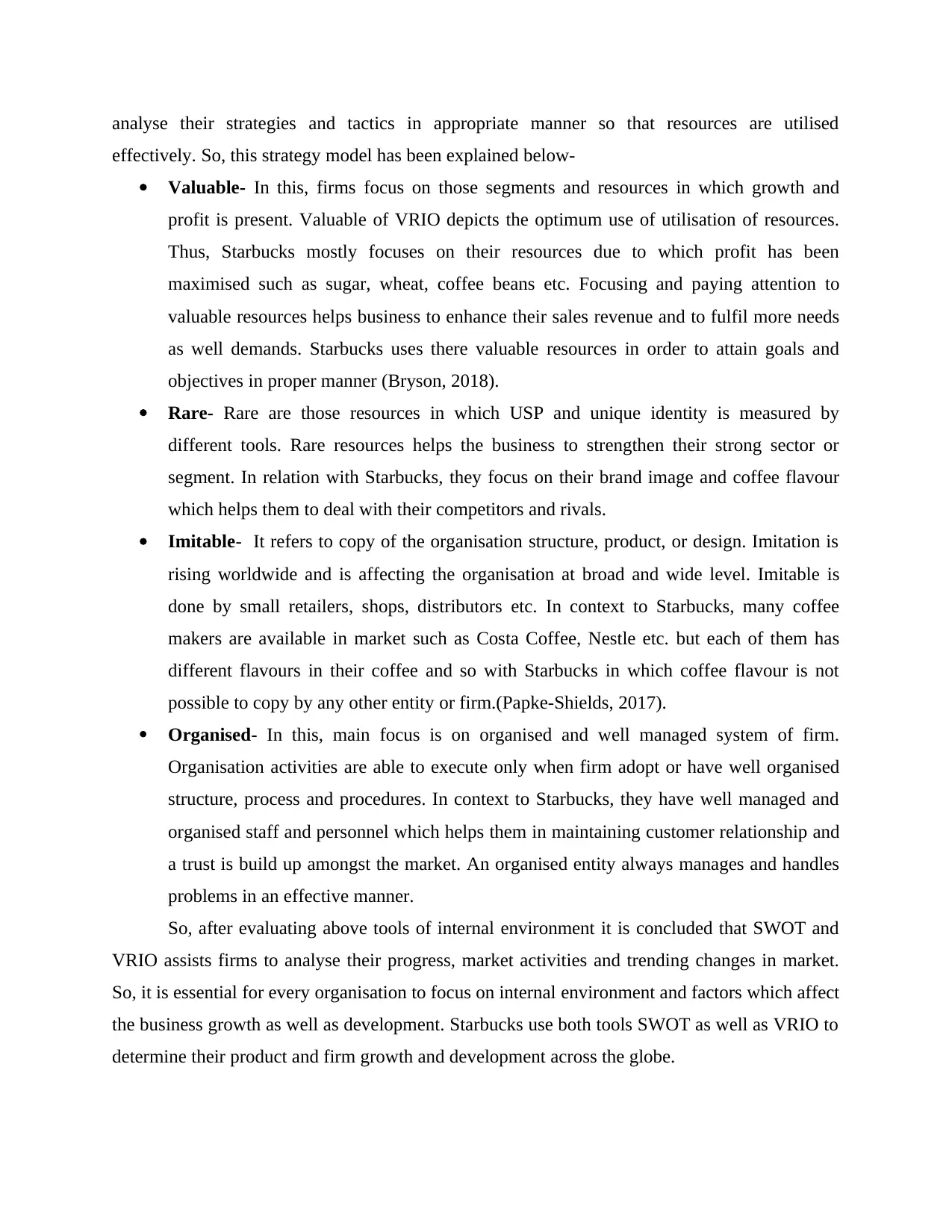
analyse their strategies and tactics in appropriate manner so that resources are utilised
effectively. So, this strategy model has been explained below-
Valuable- In this, firms focus on those segments and resources in which growth and
profit is present. Valuable of VRIO depicts the optimum use of utilisation of resources.
Thus, Starbucks mostly focuses on their resources due to which profit has been
maximised such as sugar, wheat, coffee beans etc. Focusing and paying attention to
valuable resources helps business to enhance their sales revenue and to fulfil more needs
as well demands. Starbucks uses there valuable resources in order to attain goals and
objectives in proper manner (Bryson, 2018).
Rare- Rare are those resources in which USP and unique identity is measured by
different tools. Rare resources helps the business to strengthen their strong sector or
segment. In relation with Starbucks, they focus on their brand image and coffee flavour
which helps them to deal with their competitors and rivals.
Imitable- It refers to copy of the organisation structure, product, or design. Imitation is
rising worldwide and is affecting the organisation at broad and wide level. Imitable is
done by small retailers, shops, distributors etc. In context to Starbucks, many coffee
makers are available in market such as Costa Coffee, Nestle etc. but each of them has
different flavours in their coffee and so with Starbucks in which coffee flavour is not
possible to copy by any other entity or firm.(Papke-Shields, 2017).
Organised- In this, main focus is on organised and well managed system of firm.
Organisation activities are able to execute only when firm adopt or have well organised
structure, process and procedures. In context to Starbucks, they have well managed and
organised staff and personnel which helps them in maintaining customer relationship and
a trust is build up amongst the market. An organised entity always manages and handles
problems in an effective manner.
So, after evaluating above tools of internal environment it is concluded that SWOT and
VRIO assists firms to analyse their progress, market activities and trending changes in market.
So, it is essential for every organisation to focus on internal environment and factors which affect
the business growth as well as development. Starbucks use both tools SWOT as well as VRIO to
determine their product and firm growth and development across the globe.
effectively. So, this strategy model has been explained below-
Valuable- In this, firms focus on those segments and resources in which growth and
profit is present. Valuable of VRIO depicts the optimum use of utilisation of resources.
Thus, Starbucks mostly focuses on their resources due to which profit has been
maximised such as sugar, wheat, coffee beans etc. Focusing and paying attention to
valuable resources helps business to enhance their sales revenue and to fulfil more needs
as well demands. Starbucks uses there valuable resources in order to attain goals and
objectives in proper manner (Bryson, 2018).
Rare- Rare are those resources in which USP and unique identity is measured by
different tools. Rare resources helps the business to strengthen their strong sector or
segment. In relation with Starbucks, they focus on their brand image and coffee flavour
which helps them to deal with their competitors and rivals.
Imitable- It refers to copy of the organisation structure, product, or design. Imitation is
rising worldwide and is affecting the organisation at broad and wide level. Imitable is
done by small retailers, shops, distributors etc. In context to Starbucks, many coffee
makers are available in market such as Costa Coffee, Nestle etc. but each of them has
different flavours in their coffee and so with Starbucks in which coffee flavour is not
possible to copy by any other entity or firm.(Papke-Shields, 2017).
Organised- In this, main focus is on organised and well managed system of firm.
Organisation activities are able to execute only when firm adopt or have well organised
structure, process and procedures. In context to Starbucks, they have well managed and
organised staff and personnel which helps them in maintaining customer relationship and
a trust is build up amongst the market. An organised entity always manages and handles
problems in an effective manner.
So, after evaluating above tools of internal environment it is concluded that SWOT and
VRIO assists firms to analyse their progress, market activities and trending changes in market.
So, it is essential for every organisation to focus on internal environment and factors which affect
the business growth as well as development. Starbucks use both tools SWOT as well as VRIO to
determine their product and firm growth and development across the globe.
Paraphrase This Document
Need a fresh take? Get an instant paraphrase of this document with our AI Paraphraser
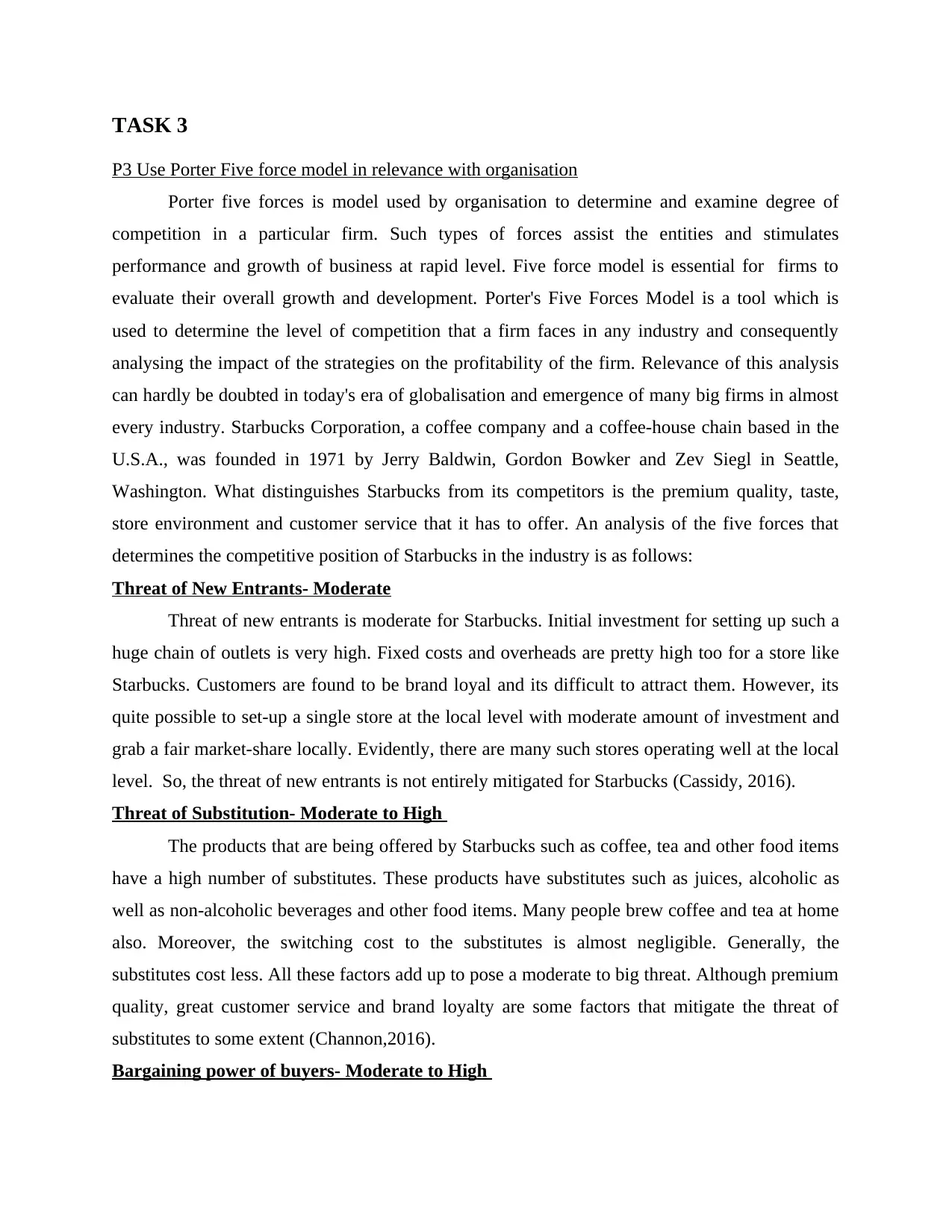
TASK 3
P3 Use Porter Five force model in relevance with organisation
Porter five forces is model used by organisation to determine and examine degree of
competition in a particular firm. Such types of forces assist the entities and stimulates
performance and growth of business at rapid level. Five force model is essential for firms to
evaluate their overall growth and development. Porter's Five Forces Model is a tool which is
used to determine the level of competition that a firm faces in any industry and consequently
analysing the impact of the strategies on the profitability of the firm. Relevance of this analysis
can hardly be doubted in today's era of globalisation and emergence of many big firms in almost
every industry. Starbucks Corporation, a coffee company and a coffee-house chain based in the
U.S.A., was founded in 1971 by Jerry Baldwin, Gordon Bowker and Zev Siegl in Seattle,
Washington. What distinguishes Starbucks from its competitors is the premium quality, taste,
store environment and customer service that it has to offer. An analysis of the five forces that
determines the competitive position of Starbucks in the industry is as follows:
Threat of New Entrants- Moderate
Threat of new entrants is moderate for Starbucks. Initial investment for setting up such a
huge chain of outlets is very high. Fixed costs and overheads are pretty high too for a store like
Starbucks. Customers are found to be brand loyal and its difficult to attract them. However, its
quite possible to set-up a single store at the local level with moderate amount of investment and
grab a fair market-share locally. Evidently, there are many such stores operating well at the local
level. So, the threat of new entrants is not entirely mitigated for Starbucks (Cassidy, 2016).
Threat of Substitution- Moderate to High
The products that are being offered by Starbucks such as coffee, tea and other food items
have a high number of substitutes. These products have substitutes such as juices, alcoholic as
well as non-alcoholic beverages and other food items. Many people brew coffee and tea at home
also. Moreover, the switching cost to the substitutes is almost negligible. Generally, the
substitutes cost less. All these factors add up to pose a moderate to big threat. Although premium
quality, great customer service and brand loyalty are some factors that mitigate the threat of
substitutes to some extent (Channon,2016).
Bargaining power of buyers- Moderate to High
P3 Use Porter Five force model in relevance with organisation
Porter five forces is model used by organisation to determine and examine degree of
competition in a particular firm. Such types of forces assist the entities and stimulates
performance and growth of business at rapid level. Five force model is essential for firms to
evaluate their overall growth and development. Porter's Five Forces Model is a tool which is
used to determine the level of competition that a firm faces in any industry and consequently
analysing the impact of the strategies on the profitability of the firm. Relevance of this analysis
can hardly be doubted in today's era of globalisation and emergence of many big firms in almost
every industry. Starbucks Corporation, a coffee company and a coffee-house chain based in the
U.S.A., was founded in 1971 by Jerry Baldwin, Gordon Bowker and Zev Siegl in Seattle,
Washington. What distinguishes Starbucks from its competitors is the premium quality, taste,
store environment and customer service that it has to offer. An analysis of the five forces that
determines the competitive position of Starbucks in the industry is as follows:
Threat of New Entrants- Moderate
Threat of new entrants is moderate for Starbucks. Initial investment for setting up such a
huge chain of outlets is very high. Fixed costs and overheads are pretty high too for a store like
Starbucks. Customers are found to be brand loyal and its difficult to attract them. However, its
quite possible to set-up a single store at the local level with moderate amount of investment and
grab a fair market-share locally. Evidently, there are many such stores operating well at the local
level. So, the threat of new entrants is not entirely mitigated for Starbucks (Cassidy, 2016).
Threat of Substitution- Moderate to High
The products that are being offered by Starbucks such as coffee, tea and other food items
have a high number of substitutes. These products have substitutes such as juices, alcoholic as
well as non-alcoholic beverages and other food items. Many people brew coffee and tea at home
also. Moreover, the switching cost to the substitutes is almost negligible. Generally, the
substitutes cost less. All these factors add up to pose a moderate to big threat. Although premium
quality, great customer service and brand loyalty are some factors that mitigate the threat of
substitutes to some extent (Channon,2016).
Bargaining power of buyers- Moderate to High
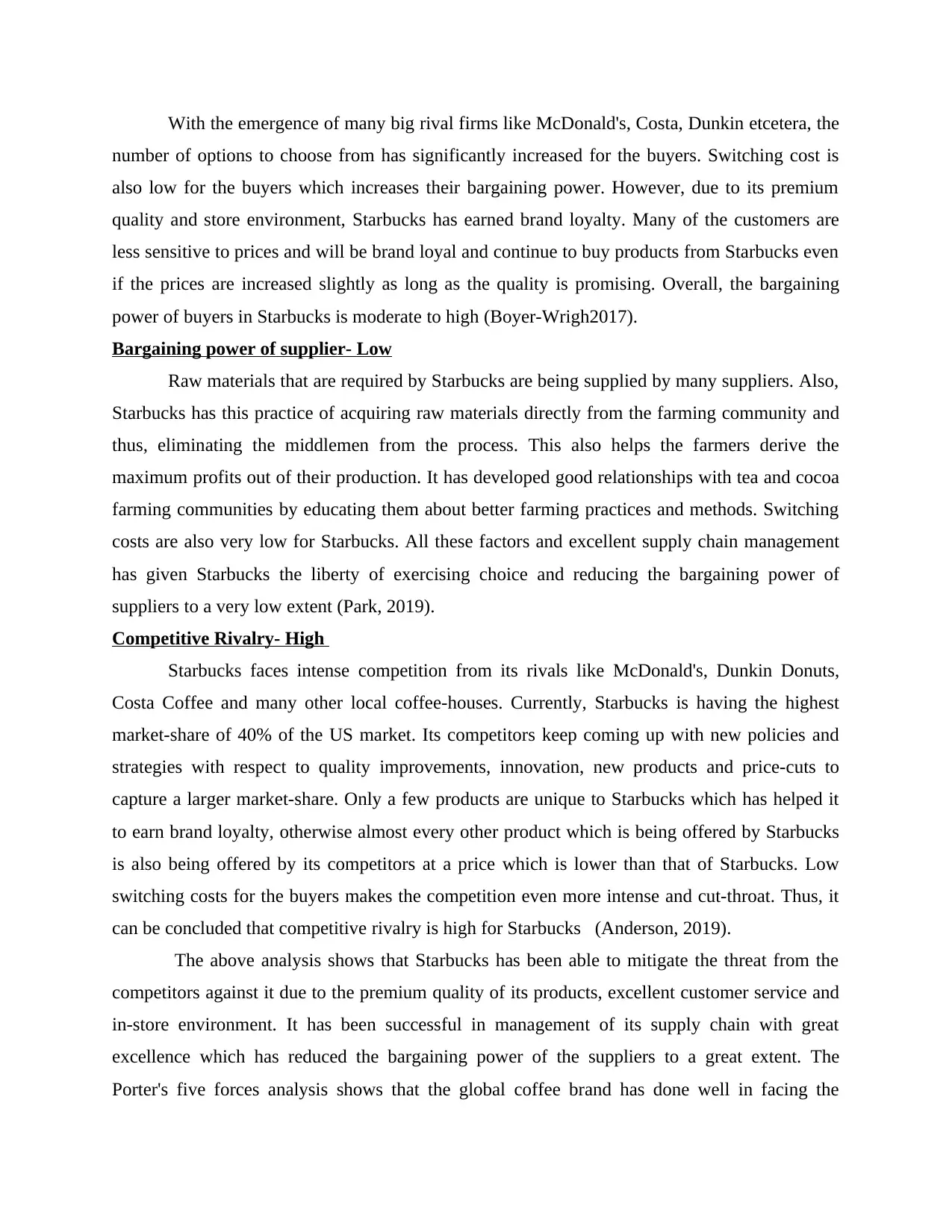
With the emergence of many big rival firms like McDonald's, Costa, Dunkin etcetera, the
number of options to choose from has significantly increased for the buyers. Switching cost is
also low for the buyers which increases their bargaining power. However, due to its premium
quality and store environment, Starbucks has earned brand loyalty. Many of the customers are
less sensitive to prices and will be brand loyal and continue to buy products from Starbucks even
if the prices are increased slightly as long as the quality is promising. Overall, the bargaining
power of buyers in Starbucks is moderate to high (Boyer-Wrigh2017).
Bargaining power of supplier- Low
Raw materials that are required by Starbucks are being supplied by many suppliers. Also,
Starbucks has this practice of acquiring raw materials directly from the farming community and
thus, eliminating the middlemen from the process. This also helps the farmers derive the
maximum profits out of their production. It has developed good relationships with tea and cocoa
farming communities by educating them about better farming practices and methods. Switching
costs are also very low for Starbucks. All these factors and excellent supply chain management
has given Starbucks the liberty of exercising choice and reducing the bargaining power of
suppliers to a very low extent (Park, 2019).
Competitive Rivalry- High
Starbucks faces intense competition from its rivals like McDonald's, Dunkin Donuts,
Costa Coffee and many other local coffee-houses. Currently, Starbucks is having the highest
market-share of 40% of the US market. Its competitors keep coming up with new policies and
strategies with respect to quality improvements, innovation, new products and price-cuts to
capture a larger market-share. Only a few products are unique to Starbucks which has helped it
to earn brand loyalty, otherwise almost every other product which is being offered by Starbucks
is also being offered by its competitors at a price which is lower than that of Starbucks. Low
switching costs for the buyers makes the competition even more intense and cut-throat. Thus, it
can be concluded that competitive rivalry is high for Starbucks (Anderson, 2019).
The above analysis shows that Starbucks has been able to mitigate the threat from the
competitors against it due to the premium quality of its products, excellent customer service and
in-store environment. It has been successful in management of its supply chain with great
excellence which has reduced the bargaining power of the suppliers to a great extent. The
Porter's five forces analysis shows that the global coffee brand has done well in facing the
number of options to choose from has significantly increased for the buyers. Switching cost is
also low for the buyers which increases their bargaining power. However, due to its premium
quality and store environment, Starbucks has earned brand loyalty. Many of the customers are
less sensitive to prices and will be brand loyal and continue to buy products from Starbucks even
if the prices are increased slightly as long as the quality is promising. Overall, the bargaining
power of buyers in Starbucks is moderate to high (Boyer-Wrigh2017).
Bargaining power of supplier- Low
Raw materials that are required by Starbucks are being supplied by many suppliers. Also,
Starbucks has this practice of acquiring raw materials directly from the farming community and
thus, eliminating the middlemen from the process. This also helps the farmers derive the
maximum profits out of their production. It has developed good relationships with tea and cocoa
farming communities by educating them about better farming practices and methods. Switching
costs are also very low for Starbucks. All these factors and excellent supply chain management
has given Starbucks the liberty of exercising choice and reducing the bargaining power of
suppliers to a very low extent (Park, 2019).
Competitive Rivalry- High
Starbucks faces intense competition from its rivals like McDonald's, Dunkin Donuts,
Costa Coffee and many other local coffee-houses. Currently, Starbucks is having the highest
market-share of 40% of the US market. Its competitors keep coming up with new policies and
strategies with respect to quality improvements, innovation, new products and price-cuts to
capture a larger market-share. Only a few products are unique to Starbucks which has helped it
to earn brand loyalty, otherwise almost every other product which is being offered by Starbucks
is also being offered by its competitors at a price which is lower than that of Starbucks. Low
switching costs for the buyers makes the competition even more intense and cut-throat. Thus, it
can be concluded that competitive rivalry is high for Starbucks (Anderson, 2019).
The above analysis shows that Starbucks has been able to mitigate the threat from the
competitors against it due to the premium quality of its products, excellent customer service and
in-store environment. It has been successful in management of its supply chain with great
excellence which has reduced the bargaining power of the suppliers to a great extent. The
Porter's five forces analysis shows that the global coffee brand has done well in facing the
⊘ This is a preview!⊘
Do you want full access?
Subscribe today to unlock all pages.

Trusted by 1+ million students worldwide
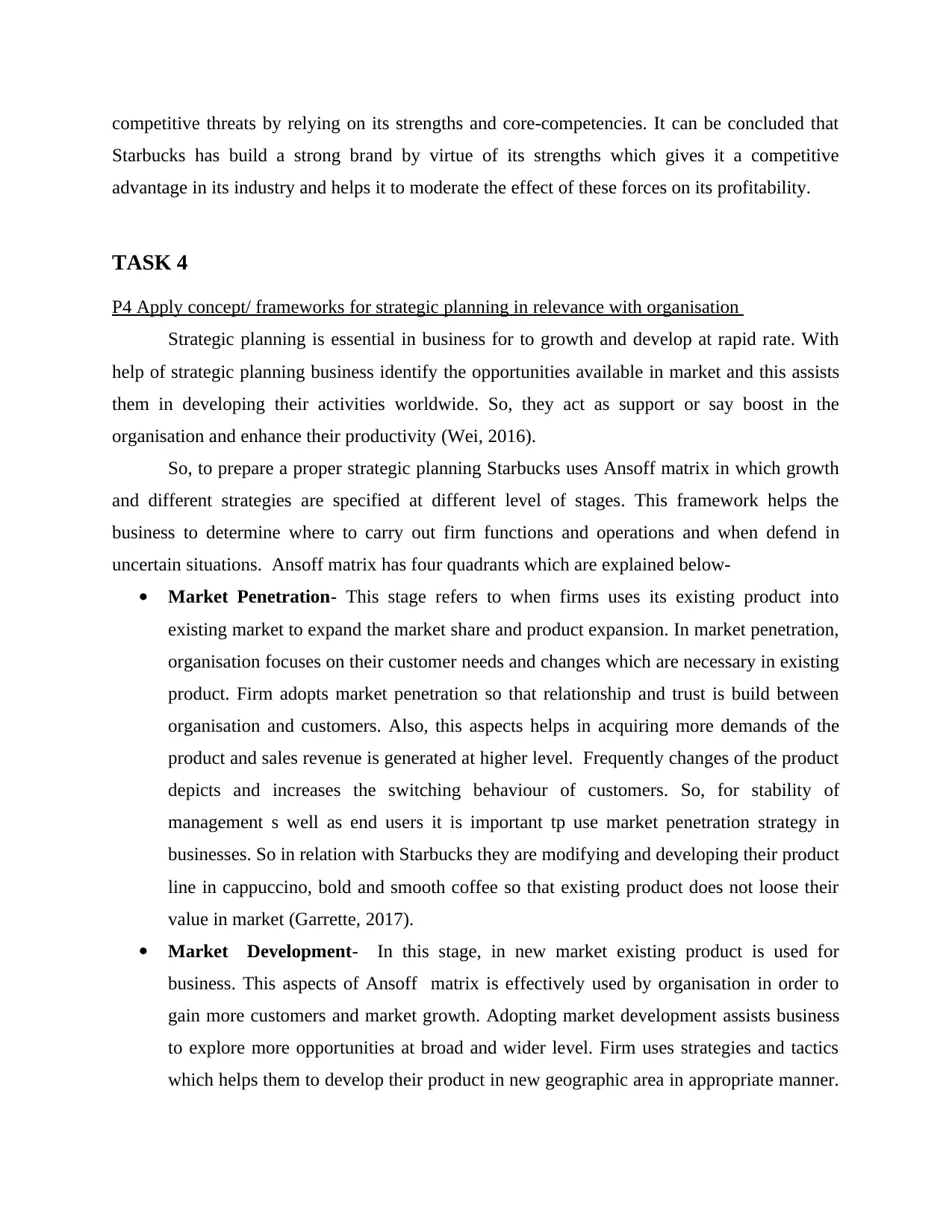
competitive threats by relying on its strengths and core-competencies. It can be concluded that
Starbucks has build a strong brand by virtue of its strengths which gives it a competitive
advantage in its industry and helps it to moderate the effect of these forces on its profitability.
TASK 4
P4 Apply concept/ frameworks for strategic planning in relevance with organisation
Strategic planning is essential in business for to growth and develop at rapid rate. With
help of strategic planning business identify the opportunities available in market and this assists
them in developing their activities worldwide. So, they act as support or say boost in the
organisation and enhance their productivity (Wei, 2016).
So, to prepare a proper strategic planning Starbucks uses Ansoff matrix in which growth
and different strategies are specified at different level of stages. This framework helps the
business to determine where to carry out firm functions and operations and when defend in
uncertain situations. Ansoff matrix has four quadrants which are explained below-
Market Penetration- This stage refers to when firms uses its existing product into
existing market to expand the market share and product expansion. In market penetration,
organisation focuses on their customer needs and changes which are necessary in existing
product. Firm adopts market penetration so that relationship and trust is build between
organisation and customers. Also, this aspects helps in acquiring more demands of the
product and sales revenue is generated at higher level. Frequently changes of the product
depicts and increases the switching behaviour of customers. So, for stability of
management s well as end users it is important tp use market penetration strategy in
businesses. So in relation with Starbucks they are modifying and developing their product
line in cappuccino, bold and smooth coffee so that existing product does not loose their
value in market (Garrette, 2017).
Market Development- In this stage, in new market existing product is used for
business. This aspects of Ansoff matrix is effectively used by organisation in order to
gain more customers and market growth. Adopting market development assists business
to explore more opportunities at broad and wider level. Firm uses strategies and tactics
which helps them to develop their product in new geographic area in appropriate manner.
Starbucks has build a strong brand by virtue of its strengths which gives it a competitive
advantage in its industry and helps it to moderate the effect of these forces on its profitability.
TASK 4
P4 Apply concept/ frameworks for strategic planning in relevance with organisation
Strategic planning is essential in business for to growth and develop at rapid rate. With
help of strategic planning business identify the opportunities available in market and this assists
them in developing their activities worldwide. So, they act as support or say boost in the
organisation and enhance their productivity (Wei, 2016).
So, to prepare a proper strategic planning Starbucks uses Ansoff matrix in which growth
and different strategies are specified at different level of stages. This framework helps the
business to determine where to carry out firm functions and operations and when defend in
uncertain situations. Ansoff matrix has four quadrants which are explained below-
Market Penetration- This stage refers to when firms uses its existing product into
existing market to expand the market share and product expansion. In market penetration,
organisation focuses on their customer needs and changes which are necessary in existing
product. Firm adopts market penetration so that relationship and trust is build between
organisation and customers. Also, this aspects helps in acquiring more demands of the
product and sales revenue is generated at higher level. Frequently changes of the product
depicts and increases the switching behaviour of customers. So, for stability of
management s well as end users it is important tp use market penetration strategy in
businesses. So in relation with Starbucks they are modifying and developing their product
line in cappuccino, bold and smooth coffee so that existing product does not loose their
value in market (Garrette, 2017).
Market Development- In this stage, in new market existing product is used for
business. This aspects of Ansoff matrix is effectively used by organisation in order to
gain more customers and market growth. Adopting market development assists business
to explore more opportunities at broad and wider level. Firm uses strategies and tactics
which helps them to develop their product in new geographic area in appropriate manner.
Paraphrase This Document
Need a fresh take? Get an instant paraphrase of this document with our AI Paraphraser

In context to Starbucks, they are using their several products such as blended coffee,
traditional coffee etc. Adopting this strategy planning, helps the business to acquire more
resources and to increase their profitability at different regions (Gürel, 2017).
Product Development- At this stage, in existing market new products are introduced. In
this, new development product is used by organisation to launch and successfully
introduced the product in the market. Also, before introducing new product a proper
market research and demographic variables such as gender, age, income etc. are analysed
properly because outcomes of new products are unknown so firm uses NPD process to
examine end user's behaviour. In relation with Starbucks, they have introduced the
Starbucks card in which points are added and those rewards points can be used by
customers on their purchasing of any product related with the company. This card also
tracks and depicts transaction history of customers also this card is used by personnel too.
Diversification- Further comes the diversification in which product as well as market
both are new. This stage is more riskier and time consuming as compared top others
aspects of Ansoff matrix. In diversification, firm adopts this stage so that business grow
faster and to increase sales revenue at wider level. Diversification leads to wider
opportunities and large market as well as profit share growth. In context to Starbucks, ,
they have started selling coffee machines and mugs to different regions so that brand
value increases and expand at rapid level. In this, cost of production is high and huge
amount of finance is required to at this stage (Bull, 2016).
After a brief stated of above strategics planning tool; Ansoff matrix, it is concluded that it
is crucial for entities to implement strategies as well as tactics according to market situation and
trends across the globe. So, strategic planning guides the business to adopt changes and to be
prepared for uncertain occurring events.
CONCLUSION
After analysing above report it is concluded that business strategy is essential for firm to
adopt for continuity of business. Strategies, entities functions as well operations are dynamic in
nature and there are factors which affect the business at broad level. PESTEL analysis assists
business to overcome with those external factors. Internal environment is also necessary in
organisation to run business activities in smooth manner. SWOT and VRIO are tools which are
traditional coffee etc. Adopting this strategy planning, helps the business to acquire more
resources and to increase their profitability at different regions (Gürel, 2017).
Product Development- At this stage, in existing market new products are introduced. In
this, new development product is used by organisation to launch and successfully
introduced the product in the market. Also, before introducing new product a proper
market research and demographic variables such as gender, age, income etc. are analysed
properly because outcomes of new products are unknown so firm uses NPD process to
examine end user's behaviour. In relation with Starbucks, they have introduced the
Starbucks card in which points are added and those rewards points can be used by
customers on their purchasing of any product related with the company. This card also
tracks and depicts transaction history of customers also this card is used by personnel too.
Diversification- Further comes the diversification in which product as well as market
both are new. This stage is more riskier and time consuming as compared top others
aspects of Ansoff matrix. In diversification, firm adopts this stage so that business grow
faster and to increase sales revenue at wider level. Diversification leads to wider
opportunities and large market as well as profit share growth. In context to Starbucks, ,
they have started selling coffee machines and mugs to different regions so that brand
value increases and expand at rapid level. In this, cost of production is high and huge
amount of finance is required to at this stage (Bull, 2016).
After a brief stated of above strategics planning tool; Ansoff matrix, it is concluded that it
is crucial for entities to implement strategies as well as tactics according to market situation and
trends across the globe. So, strategic planning guides the business to adopt changes and to be
prepared for uncertain occurring events.
CONCLUSION
After analysing above report it is concluded that business strategy is essential for firm to
adopt for continuity of business. Strategies, entities functions as well operations are dynamic in
nature and there are factors which affect the business at broad level. PESTEL analysis assists
business to overcome with those external factors. Internal environment is also necessary in
organisation to run business activities in smooth manner. SWOT and VRIO are tools which are
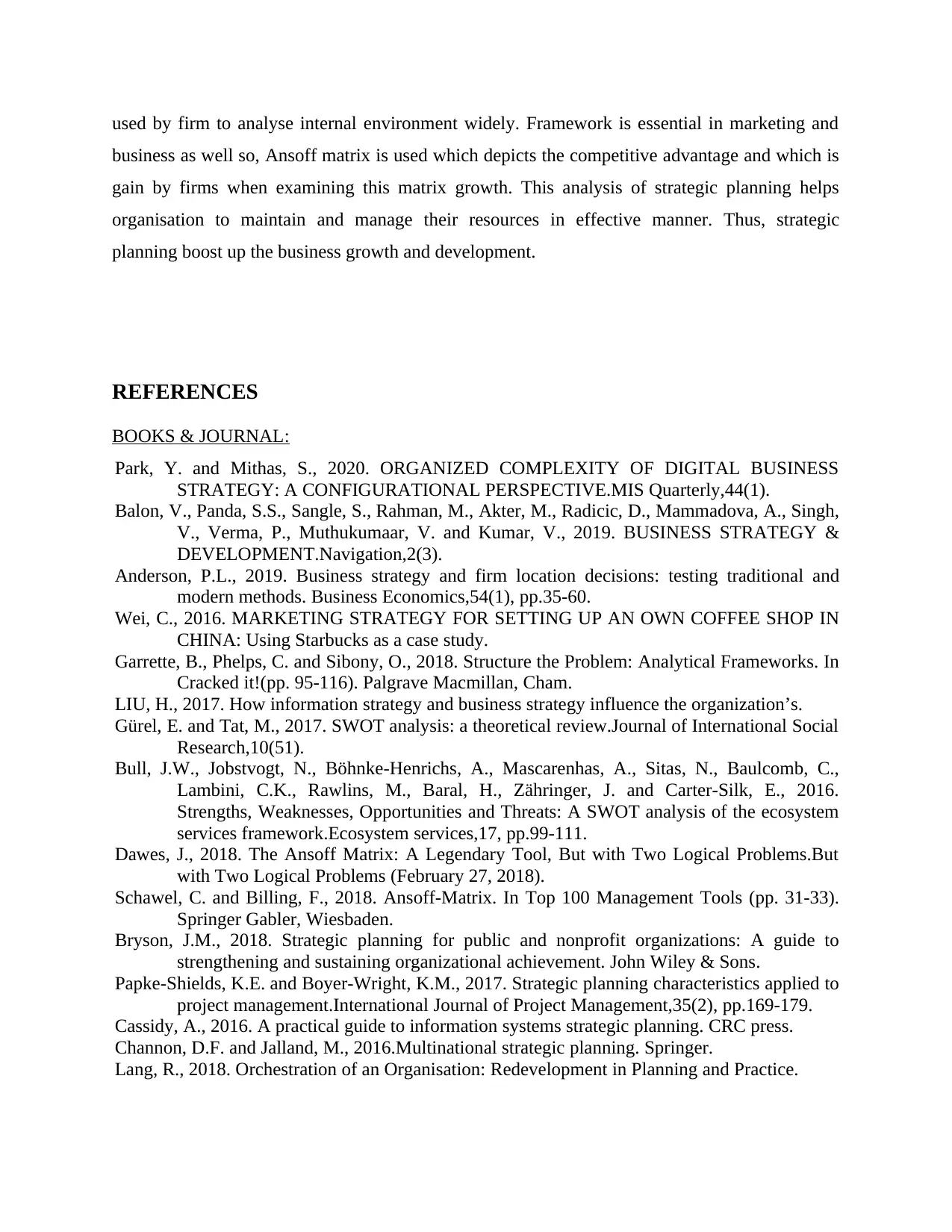
used by firm to analyse internal environment widely. Framework is essential in marketing and
business as well so, Ansoff matrix is used which depicts the competitive advantage and which is
gain by firms when examining this matrix growth. This analysis of strategic planning helps
organisation to maintain and manage their resources in effective manner. Thus, strategic
planning boost up the business growth and development.
REFERENCES
BOOKS & JOURNAL:
Park, Y. and Mithas, S., 2020. ORGANIZED COMPLEXITY OF DIGITAL BUSINESS
STRATEGY: A CONFIGURATIONAL PERSPECTIVE.MIS Quarterly,44(1).
Balon, V., Panda, S.S., Sangle, S., Rahman, M., Akter, M., Radicic, D., Mammadova, A., Singh,
V., Verma, P., Muthukumaar, V. and Kumar, V., 2019. BUSINESS STRATEGY &
DEVELOPMENT.Navigation,2(3).
Anderson, P.L., 2019. Business strategy and firm location decisions: testing traditional and
modern methods. Business Economics,54(1), pp.35-60.
Wei, C., 2016. MARKETING STRATEGY FOR SETTING UP AN OWN COFFEE SHOP IN
CHINA: Using Starbucks as a case study.
Garrette, B., Phelps, C. and Sibony, O., 2018. Structure the Problem: Analytical Frameworks. In
Cracked it!(pp. 95-116). Palgrave Macmillan, Cham.
LIU, H., 2017. How information strategy and business strategy influence the organization’s.
Gürel, E. and Tat, M., 2017. SWOT analysis: a theoretical review.Journal of International Social
Research,10(51).
Bull, J.W., Jobstvogt, N., Böhnke-Henrichs, A., Mascarenhas, A., Sitas, N., Baulcomb, C.,
Lambini, C.K., Rawlins, M., Baral, H., Zähringer, J. and Carter-Silk, E., 2016.
Strengths, Weaknesses, Opportunities and Threats: A SWOT analysis of the ecosystem
services framework.Ecosystem services,17, pp.99-111.
Dawes, J., 2018. The Ansoff Matrix: A Legendary Tool, But with Two Logical Problems.But
with Two Logical Problems (February 27, 2018).
Schawel, C. and Billing, F., 2018. Ansoff-Matrix. In Top 100 Management Tools (pp. 31-33).
Springer Gabler, Wiesbaden.
Bryson, J.M., 2018. Strategic planning for public and nonprofit organizations: A guide to
strengthening and sustaining organizational achievement. John Wiley & Sons.
Papke-Shields, K.E. and Boyer-Wright, K.M., 2017. Strategic planning characteristics applied to
project management.International Journal of Project Management,35(2), pp.169-179.
Cassidy, A., 2016. A practical guide to information systems strategic planning. CRC press.
Channon, D.F. and Jalland, M., 2016.Multinational strategic planning. Springer.
Lang, R., 2018. Orchestration of an Organisation: Redevelopment in Planning and Practice.
business as well so, Ansoff matrix is used which depicts the competitive advantage and which is
gain by firms when examining this matrix growth. This analysis of strategic planning helps
organisation to maintain and manage their resources in effective manner. Thus, strategic
planning boost up the business growth and development.
REFERENCES
BOOKS & JOURNAL:
Park, Y. and Mithas, S., 2020. ORGANIZED COMPLEXITY OF DIGITAL BUSINESS
STRATEGY: A CONFIGURATIONAL PERSPECTIVE.MIS Quarterly,44(1).
Balon, V., Panda, S.S., Sangle, S., Rahman, M., Akter, M., Radicic, D., Mammadova, A., Singh,
V., Verma, P., Muthukumaar, V. and Kumar, V., 2019. BUSINESS STRATEGY &
DEVELOPMENT.Navigation,2(3).
Anderson, P.L., 2019. Business strategy and firm location decisions: testing traditional and
modern methods. Business Economics,54(1), pp.35-60.
Wei, C., 2016. MARKETING STRATEGY FOR SETTING UP AN OWN COFFEE SHOP IN
CHINA: Using Starbucks as a case study.
Garrette, B., Phelps, C. and Sibony, O., 2018. Structure the Problem: Analytical Frameworks. In
Cracked it!(pp. 95-116). Palgrave Macmillan, Cham.
LIU, H., 2017. How information strategy and business strategy influence the organization’s.
Gürel, E. and Tat, M., 2017. SWOT analysis: a theoretical review.Journal of International Social
Research,10(51).
Bull, J.W., Jobstvogt, N., Böhnke-Henrichs, A., Mascarenhas, A., Sitas, N., Baulcomb, C.,
Lambini, C.K., Rawlins, M., Baral, H., Zähringer, J. and Carter-Silk, E., 2016.
Strengths, Weaknesses, Opportunities and Threats: A SWOT analysis of the ecosystem
services framework.Ecosystem services,17, pp.99-111.
Dawes, J., 2018. The Ansoff Matrix: A Legendary Tool, But with Two Logical Problems.But
with Two Logical Problems (February 27, 2018).
Schawel, C. and Billing, F., 2018. Ansoff-Matrix. In Top 100 Management Tools (pp. 31-33).
Springer Gabler, Wiesbaden.
Bryson, J.M., 2018. Strategic planning for public and nonprofit organizations: A guide to
strengthening and sustaining organizational achievement. John Wiley & Sons.
Papke-Shields, K.E. and Boyer-Wright, K.M., 2017. Strategic planning characteristics applied to
project management.International Journal of Project Management,35(2), pp.169-179.
Cassidy, A., 2016. A practical guide to information systems strategic planning. CRC press.
Channon, D.F. and Jalland, M., 2016.Multinational strategic planning. Springer.
Lang, R., 2018. Orchestration of an Organisation: Redevelopment in Planning and Practice.
⊘ This is a preview!⊘
Do you want full access?
Subscribe today to unlock all pages.

Trusted by 1+ million students worldwide
1 out of 13
Related Documents
Your All-in-One AI-Powered Toolkit for Academic Success.
+13062052269
info@desklib.com
Available 24*7 on WhatsApp / Email
![[object Object]](/_next/static/media/star-bottom.7253800d.svg)
Unlock your academic potential
Copyright © 2020–2025 A2Z Services. All Rights Reserved. Developed and managed by ZUCOL.




